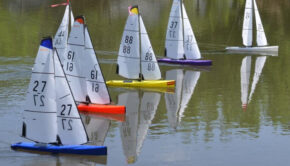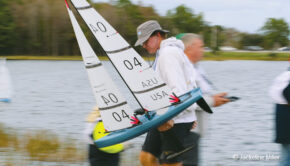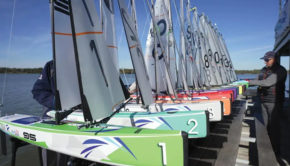Record fleets for Radio Sailing Worlds
Published on May 23rd, 2018
The 2018 IRSA (International Radio Sailing Association) World Championship expects 120 participants from 16 countries to compete in Biblis Riedsee, Germany. On May 24-26, competitors will be sailing to crown the 9th Ten Rater Class World Champion, and from May 27 to June 1 the racing will be for the title of 18th Marblehead Class World Champion.
A field of 60 participants has registered for the World Championships in the Ten Rater class. In the Marblehead class, a fully booked field with 84 participants can be expected for the first time. Never in these classes has a Worlds had a larger field of participants.
Some of the Top Sailors are:
Brad Gibson GBR 42
He is the defending champion in both classes and so will certainly put a lot of pressure on his shoulders. He has since been beaten at any event with his constructed for the 2016 World Cup Ten Rater “Trance”. For the first time this year, other participants from England and Australia will use this design. Also unbeaten but since 2012 he is in the Marblehead class with his “grunge”. This boat is now driven by a larger number of other sailors. With this boat Brad Gibson now three times in a row World Champion (2012 Ploermel / France, 2014 Gouda / Netherlands, 2016 Limone / Italy) remains the question of whether it will succeed in Germany for the fourth time.
Graham Bantock GBR 95
Multiple World, European champion in all classes. Second of the World Championships 2012 & 2014 third in the Marblehead class he will try to get the most out of his own design “Quark”. In the Ten Rater class, also with his own design “Diamond”, he had to settle for second place in 2016, but he will do his utmost to get the title back.
Matteo Longhi ITA 24
Winner of the national championships in France, Italy and Switzerland. He will certainly put considerable pressure on the English at the top. Most recently, he managed a close second place at the 2016 Marblehead World Championships behind Brad Gibson. He will also compete in the Ten Rater class and try to get to the top with Marc Pomarede’s new French design.
Martin Roberts GBR 55
World Champion of the Marblehead class 2006, third 2012, he was able to achieve in 2016 with the slightly older boat only 13th place. He will compete this year with a new design, the French “Nioutram” and is also a favorite for the world title.
Rèmi Brês FRA 48
For years at the top of the world Rèmi entered places in the top ten in the world. For 20 years he drove the same boat a “Margo” by Paul Lucard. This year he starts with a new design. Like Matteo Longhi, he is expected with a nioutram by Marc Pomerade. It will be exciting what the experienced sailor Rèmi Brês can get out of the design.
Additional details:
• worlds2018.marbleheadclass.org
• worlds2018.tenrater.org
• radiosailing.org
About the Marblehead Class
The International Marblehead (M) class is probably the most exciting to sail with its moderate size and light weight combined with high maneuverability and stability. Essentially a box rule with minimal constraints. A modern M will usually be made almost entirely of carbon fibre – hull, foils, spars and fittings. The class was the first to adopt hi tech construction in the early 90s and development since then has been limited. This permits almost all boats built since then to be compete well in modern fleets. The class is quite often referred to as the “Formula One” of radio sailing.
• Hull length 1.3 m
• Displacement 4.5 to 5.5 kg
• Draught 660 mm
• Sail area 0.5161 m²
About the Ten Rater Class
Boats in the International Ten Rater (10R) class are not limited in length by the class rules and usually have overhangs extending beyond their waterline endings. They are generally light, narrow, stable, seaworthy and fast. This IRSA international rule is based on the 1887 “length and sail area rating rule” which allows shorter waterline length boats to have higher sail areas, while longer LWL boats have smaller sails. It is an ‘open’ rule with great freedom to develop design and construction, particularly in rigs and sail plans. Many different hull forms can be found in the 10R class. A modern 10R will usually be made almost entirely of carbon fibre – hull, foils, spars and fittings.
• Hull length 1.3 to 1.8 m
• Displacement 5 to 7 kg
• Draught 700 mm
• Sail area 0.9 to 1.1 m²
Source: Henning Faas, IRSA









 We’ll keep your information safe.
We’ll keep your information safe.